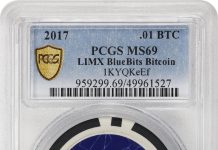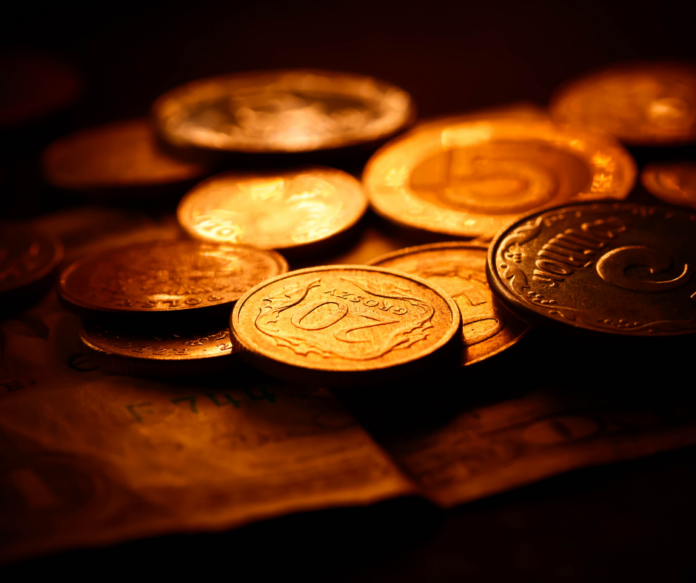
Vintage gold commemorative coins were minted by the United States from 1903 to 1926. These coins honor persons, places, or events and are sold by the U.S. Mint at prices above the face value of the coin, often to help raise funds for a worthy cause.
Determining Value
Many factors determine the value of these gold coins. Does the coin’s surface display scratches from rubbing against other coins during shipping? Unsightly scratches lower the grade, desirability, and value.
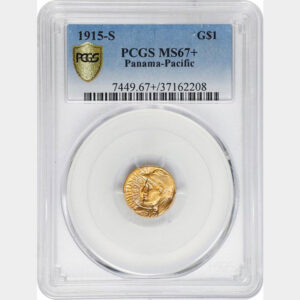 Where were the coins stored? If these gold coins, which were manufactured with some copper, were stored in a moist environment such as in Florida by the ocean, the moisture could serve as a catalyst to react with the copper to cause unsightly brown spots. Some people like these spots because it shows the coin hasn’t been cleaned or tampered with, but others dislike brown-spotted gold coins and will pay less money for them.
Where were the coins stored? If these gold coins, which were manufactured with some copper, were stored in a moist environment such as in Florida by the ocean, the moisture could serve as a catalyst to react with the copper to cause unsightly brown spots. Some people like these spots because it shows the coin hasn’t been cleaned or tampered with, but others dislike brown-spotted gold coins and will pay less money for them.
A gold commemorative coin that has been tissue wiped or lightly cleaned is not desirable. Tissue wiping causes crisscrossing parallel striations that are visible under a pinpoint light source such as a Tensor lamp.
The detail of the design that the coin designer meant for the coin to display after manufacture might lack as a result of the production process. The engraved die used to manufacture a coin might lose detail after striking many coins, and the coin might, therefore, lack important detail before even leaving the Mint. These coins are referred to as weakly struck.
A weakly struck coin has a lower value than a coin with an average strike or one which is extremely sharp and well-struck.
Other factors such as the popularity of an issue, availability in a grade, and its cost plus the number of coins encapsulated or slabbed by independent third-party grading services such as the Numismatic Guaranty Company (NGC) and the Professional Coin Grading Service (PCGS) all impact the value. These two grading services publish the number of coins in each respective grade that they certify.
Like other U.S. coins, gold commemorative coins are graded or rated on a scale of one through 70. One represents a coin that is so well worn it is barely identifiable as to its type, and a gold coin rated 70 appears perfect under a five-power magnifying glass. 60 through 70 are the Mint State grades: These coins exhibit no signs of having circulated such as wear on their highest points. 60 is the lowest Mint State grade and although Uncirculated, a 60-rated coin might have many unsightly scratches or marks. 65 is “Gem.”
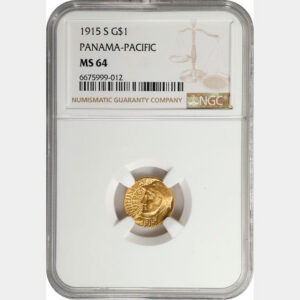 Louisiana Purchase Exposition Gold Dollars
Louisiana Purchase Exposition Gold Dollars
Thomas Jefferson was the first U.S. President to appear on gold commemorative coinage. He is portrayed on a one dollar gold coin dated 1903 which commemorates the 100th anniversary of the Louisiana Purchase.
Officials of the U.S. Mint decided to also memorialize President William McKinley, who signed the bill that sanctioned the Louisiana Purchase Exposition and depict him as a part of the 1903 Louisiana Purchase commemorative one dollar gold coin. We refer to this as the McKinley gold dollar, Type 2 for the issue.
Even though these coins can be spent for one dollar in commerce, you wouldn’t want to spend them because these tiny coins contain 90% gold and have a gold value alone of over $200.
Let’s compare both of these Louisiana Purchase Exposition gold commemorative dollars: The Jefferson and McKinley issues have an estimated combined final mintage figure of 17,375 after 215,250 examples were melted.
The McKinley is undervalued in grades MS-63 through MS-66. Values range from $400 in XF-45 through $660 in Mint State-64. MS-65 (Gem) through MS-66 are worth from $900 to $1,200 respectively.
The Certified Acceptance Corporation (CAC) places green holographic stickers on PCGS and NGC holders of coins it feels are solidly graded or high-end for their grades. CAC is expected to be a fully functional grading service that encapsulates coins by the end of the year.
It only costs $150 more for one of these Jefferson or McKinley issues with a CAC sticker in grade MS-65 and $200 more for one of these issues graded MS-66.
In general, the CAC-verified MS-65 and CAC-verified MS-66 gold commemorative coins are considered far superior to their non-CAC counterparts. One caveat: Many PCGS and NGC coins have not been submitted to CAC. So if a holder doesn’t have a CAC green sticker, that doesn’t mean the coin was submitted to CAC and not stickered.
1903 McKinley gold dollars graded XF-45 are valued at $270, while the About Uncirculated-55 counterpart is worth $290. MS-60 McKinley gold dollars are a better value than the Jefferson gold dollars of the same grade. In fact, McKinley gold dollars are better values than Jefferson gold dollars up to and including the grade of MS-66. My opinion as an expert is that the McKinley gold dollars are significantly rarer than their Jefferson gold dollar counterparts. Pricing of these two different coins doesn’t reflect this.
In, MS-65 there is a $250 premium for CAC green sticker holders and a $300 premium for MS-66. These premiums are well deserved.
The 1903 McKinley certified as MS-67 has an $1,800 value. But with a CAC sticker, the coin is worth nearly $1,000 more and will set you back about $2,750. CAC is strict, and the premiums their verified coins command bear this out.
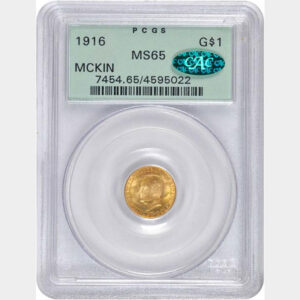 Lewis & Clark Gold Dollars
Lewis & Clark Gold Dollars
To commemorate the 100th Anniversary of the exploration of the Northwest or Louisiana Territory and Oregon Country, the U.S. government decided to have a commemorative gold dollar coin produced. That coin memorializes and honors the explorers Capt. Meriwether Lewis and Capt. William Clark at the anniversary Exposition held in their honor in Portland, Oregon. Because of the size of this issue, Lewis’s portrait was placed on the obverse or front of the coin, and Clark’s image was placed on the reverse or back of the coin.
In grades XF-45 through MS-60 there is little price difference. These coins are worth about $650 each. MS-63 and MS-64 certified by NGC and PCGS also have little value difference, with coins in both grades valued retail at about $1,300. MS-62 is an ambiguous grade, and coins in this grade would not be my first choice to purchase.
When buying an NGC or PCGS Lewis and Clark gold dollar, there is a $400+ price premium should the slab have a CAC sticker.
1905 Lewis and Clark gold dollars graded MS-65 are beautiful coins but can be a challenge to acquire. The estimated NGC or PCGS-certified coin value for this issue is $4,500 without the CAC sticker. But a CAC-verified example can be worth $8,500 or more.
The 1904 Lewis and Clark gold dollar graded MS-65 is a $2,200 coin. But with the CAC sticker, the price doubles to $4,400.
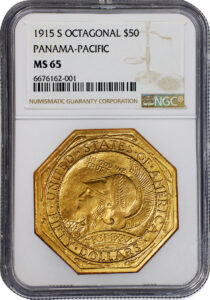 Panama Pacific Gold Coins
Panama Pacific Gold Coins
After an approximate 10-year hiatus, 1915-S (San Francisco) gold issues were produced. The 1915-S Panama Pacific gold dollar (15,000 minted) is the second most available U.S. commemorative gold dollar created after the 1916 and 1917 McKinley issues. The Panama Pacific gold coinage commemorates the completion of the Panama Canal.
I do not recommend purchase of these beautiful coins at this time, as other issues represent better value and make for a better investment. However, if the joy of collecting grades MS-66 and MS-67 is part of your artistic appreciation strategy, by all means purchase these coins. Just don’t expect that they will rise in value quickly.
NGC and PCGS value for MS-67 Pan-Pac $1 gold coins is $3,600. With a CAC sticker, expect to pay $4,800.
Quarter Eagle Gold
The beautiful 1915-S $2-1/2 (quarter eagle gold) issue is extremely popular with collectors. 6,794 were minted. If you desire one, go for it in all grades: XF-45 ($1,340); MS-60 ($2,100); MS-63 ($3,100); MS-64 ($3,500); and MS-65 ($3,900, with CAC at $4,150). Rated MS-66 by NGC and PCGS, $4,800 is a fair price, with CAC’s $5,500 price also being fair. One grade higher, MS-67, this quarter eagle gold issue jumps in value to $7,700, with a CAC-verified example commanding $11,000.
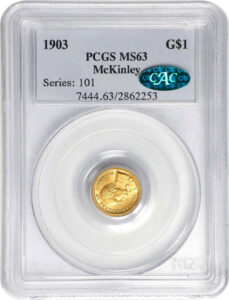 McKinley Gold
McKinley Gold
The 1916 and 1917 McKinley issues, with 10,000 approximate mintages apiece, are less popular with collectors. Their values are lower. I favor the 1916 specimens, especially in MS-66 NGC and PCGS, where the price is $720. CAC-verified specimens command $1,100. MS-67 is a $1,700 coin graded by PCGS or NGC, but CAC-verified coins bring $3,000. Again, the CAC price differential reflects CAC’s tight standards. The 1917 specimens have significantly higher prices.
The reason for the issue is to commemorate the completion of a memorial for U.S. President William McKinley in Niles, Ohio.
Our 1917 McKinley gold commemorative dollar is a decent investment graded MS-64 by PCGS or NGC ($540), with a CAC specimen commanding $700. The coin when rated MS-65 by NGC or PCGS costs $650, but a CAC example is priced at $1,050.
I like the 1917 McKinley in MS-66 PCGS or NGC ($930), with CAC at $1,700. I also like this issue in the grade of MS-67 NGC or PCGS ($1,900) and CAC $3,800. CAC does not grade verify that many NGC and PCGS assigned grades.
Grant Gold Dollars
The 1922 Grant gold dollars were minted with a star and without a star above the name Grant. Both have the lowest mintage (5,000 each) for the issue and the lowest mintage for the entire gold dollar and $2-1/2 gold commemorative series.
The Grant gold dollar without the star is also referred to as the Grant Plain. The Grant with Star was issued first, and hoarded by collectors because it was something novel. By the time the without star example was released, the novelty wore off, and the coins were not as carefully handled.
Grant Plain MS-65 NGC and PCGS examples command $1,400. CAC examples are worth $1,700.
These gold coins were made to commemorate the 100th anniversary of the birth of U.S. President Ulysses Grant.
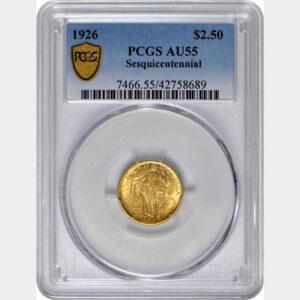 1926 Sesquicentennial Gold
1926 Sesquicentennial Gold
The last of the commemorative gold issues from the U.S. Mint was the 1926 Sesquicentennial $2-1/2 or quarter eagle gold coin. It has the highest mintage (45,793) of the eleven coins which make up the complete 11-coin set.
The Sesquicentennial commemorative coins memorialized the 150th anniversary of the signing of the Declaration of Independence.
The Sesqui gold coin is readily available in grades MS-60 through MS-64 graded by PCGS or NGC. These coins are fairly priced depending on grade in the $500-$700 range. When graded MS-65 by NGC or PCGS expect to pay $1,250. CAC examples command $2,400.
In MS-66 condition, the NGC or PCGS asking price is $4,500, while a CAC coin has a $7,500 value. It is the Sesqui which is the second most difficult to acquire graded MS-66, followed by the 1904 Lewis and Clark issue.
A Sesqui $2-1/2 gold coin certified as MS-67, either in an NGC or PCGS holder, will be priced at $30,000. A CAC example, extremely rare to locate, is a $45,000 coin.
Dream Gold Commemorative Coin
We addressed many affordable and out-of-budget coins, all part of the 11-coin vintage gold commemorative set. But no discussion of commemorative gold coins can be complete without at least an honorable mention of the highly important $50 Round and Octagonal issues.
An NGC or PCGS 1915-S Octagonal Panama-Pacific commemorative $50 gold piece, which commands $150,000 in the MS-65 grade, contains about two and a half ounces of gold.
This article about gold commemorative coins previously appeared in COINage magazine. To subscribe click here. Article by Anthony Swiatek. Photos Courtesy Stack’s Bowers Auctions.

